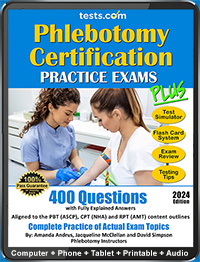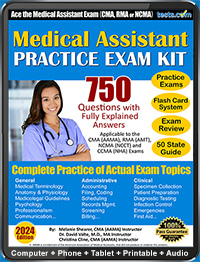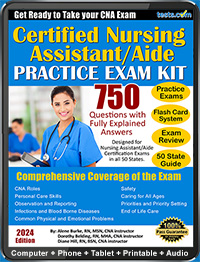Phlebotomy Test Guide
| The Phlebotomy Test Summary
|
|
|---|---|
| What: These exams offer professional certification for phlebotomists. | |
| Who: Each exam carries different requirements, but generally phlebotomists must have completed an accredited program and have laboratory experience. | |
| Where: Tests are offered nationwide. | |
| When: Tests are offered year-round. | |
| How: Tests are administered via the computer and pencil-and-paper, depending on the testing organization. | |
| Type: Exams are typically multiple-choice and include a lab component. | |
| Why: The test is a requirement for phlebotomy certification. | |
| Time: Varies. | |
| Language: English. | |
| Preparation: A variety of test preparation materials are available for purchase and review. | |
| Cost: Test fees vary depending on the administering organization. | |
By Erin Hasinger, Tests.com
Professional certification as a phlebotomist is obtained through a combination of education, experience and an exam. At least ten different organizations offer certification for phlebotomists. This article will review three of the major phlebotomy certification organizations and offer information on exam requirements and registration: the National Phlebotomy Association, American Society for Clinical Pathology and the American Society of Phlebotomy Technicians.
Generally speaking, a phlebotomy certification exam will include questions on the following topics:
- Arterial Puncture Procedures
- Blood Collection Procedures and Equipment
- Circulatory System
- Human Anatomy and Physiology
- Infection Control
- Medical Terminology
- Non-blood Specimens
- Safety
- Skin Puncture Equipment and Procedures
- Venipuncture Specimen Collection
National Phlebotomy Association
One major certification organization is the National Phlebotomy Association (NPA). More than 15,000 phlebotomists in the United States have been certified by the NPA since 1981. The NPA awards certification to phlebotomists who have completed an approved phlebotomy program that offers at least 160 hours of lecture and 200 practicum hours.
Registration forms are available at www.nationalphlebotomy.org. Applicants must complete the form and return it by mail to the address listed at the top of the form. The completed application form must be accompanied by the $130 registration fee, which is only payable by money order or certified check.
Applicants must provide detailed information about their education, including their total number of hours and start and completion dates, and must include a transcript. Applicants must also provide the names of two personal references.
Applicants must indicate the city in which they would most prefer to take the exam. Test sites are selected by the NPA, and applicants will be notified of their test site following approval to test. Test candidates will need to bring a photo ID and pencils to the exam.
The two-part exam includes a two-hour written exam and a one-hour practical exam. The exam is a pencil-and-paper exam. Scores are mailed approximately eight to ten weeks following the exam. Test candidates need to score at least 70 percent to pass. Certification is valid for one year.
American Society for Clinical Pathology
Another organization that offered phlebotomy certification is the American Society for Clinical Pathology (ASCP). Since 1928, they have certified more than 430,000 health care workers.
Eligibility requirements for the ASCP certification include 40 classroom hours that must include courses in lab operations, anatomy, physiology, and specimen collection and processing. Applicants must also have 120 hours of practical training.
Exams are offered nationwide at PearsonVUE test centers. ASCP offers the test in ten test windows that fall throughout the year. Exams are computer-adaptive, which means the questions increase in difficulty depending on how well the previous questions were answered. The exams are comprised of 100 questions, and two-and-a-half hours are given to complete the exam. Registration forms may be found online at www.ascp.org.
Following the exam, a preliminary score will be shown on the computer screen, and approximately ten days after the exam, an official score report will be mailed to the test taker’s home. Scores are scaled; applicants must score 400 to pass.
American Society of Phlebotomy Technicians
A third major certifying organization is the Association of Phlebotomy Technicians (APT). Requirements for certification include completion of an accredited program in phlebotomy and hands-on training that includes 100 successful vein punctures and five successful skin punctures. Membership in APT is also required; to be eligible for membership, candidates must have worked full-time for six months or part-time for twelve months.
Registration forms may be found at www.aspt.org. The exam carries a $55 fee that must be paid when the registration form is submitted. When registering for the exam, applicants may indicate the city in which they would like to take the exam. If current exam accommodations do not exist, ASPT may be able to work with a phlebotomy instructor in the area to host an exam.
Scores are sent to test candidates six to eight weeks after the exam date.
Other certification organizations for phlebotomists are as follows: American Certification Agency, American Medical Technologists, International Academy Phlebotomy Sciences Inc., National Association of Health Professionals, National Credentialing Agency, National Center for Competency Testing and National Healthcareer Association.
For more information and test preparation materials for phlebotomy exams, please see our Phlebotomy Certification Test Directory.






